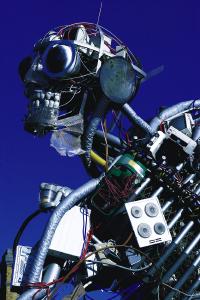Understanding the scope of the WEEE Directive

Symbolising the scale of waste electrical and electronic equipment is the 3 t of such waste likely to be consumed by an average person in the UK in their lifetime and used to create this 7 m-high human figure. The WEEE Man, built by the Royal Society of Arts, with support from Canon Europe, is outside the City Hall in London until 27 May and then at the Eden Project in Cornwall for the summer.
Among the waste equipment is computer mice for the teeth, an old washing machine to form the spine and vacuum-cleaner tubes for the neck.
90% of the million tonnes of WEEE thrown away by households and business in the UK in a year ends up as landfill.
MIKE DUGGAN explains why guidance is needed on the Waste Electrical & Electronic Equipment Directive and where you can find it.During the years leading up to the introduction of the Waste Electrical & Electronic Equipment Directive into UK law there has been confusion over what products are included in its scope (and, therefore, the UK legislation) and what products are excluded. In October 2004, FETA produced a short guidance paper that collected together the best available information as it stood at the time. This information is still very much current [April 2005]. In an annex of the directive under ‘Large Household appliances’, examples include large cooling appliances, other large appliances for refrigeration, conservation and storage of food; electric fans and air-conditioning appliances. People were unsure if all air-conditioning systems were included or just mobile units. There was also confusion whether commercial refrigerated display cabinets of the type found in supermarkets were included or not.
Available guidance Over the past two years, there has been useful guidance which is helping to clear up the confusion over scope, or ‘grey areas’ as they have become known. In March 2003 in a letter to FETA to clarify the scope of the WEEE and RoHS Directives to air conditioning and refrigeration appliances, the DTI stated: ‘We concur with your view that items such as air-conditioning systems, which are installed within the fabric of a building, should be excluded from the scope of the directives. This view has been expressed to the commission.’ In March 2004, FETA contacted the DTI saying that we wished to confirm that our understanding was still correct, that air conditioning systems that are permanently fixed into a building are outside the scope. The DTI again confirmed this. From this advice we continued to advise FETA members that ‘installed’ equipment was outside of the scope of the directive (such as split-system air conditioning, commercial refrigerated display cabinets and fans installed into a hole in the wall and hard wired into the mains supply) and that only equipment such as mobile air conditioning, integral display cabinets (of the type holding chilled drinks in forecourt shops) and stand alone fans with a 13 A plug would be within the scope. During the third consultation with industry in July 2004, the DTI issued a series of six consultation papers. One of these is the draft non-statutory guidance on the WEEE Directive. This 50-page document is full of very useful guidance on how to comply with the regulations and it is available as a download from www.dti.gov.uk/sustainability/weee/index.htm. FETA recommends this to any member struggling with the requirements of the directive, as it breaks it down into sections that are easily understood. Annex B of the DTI draft guidance document contains a decision tree that can be used to decide whether or not a product might come within the scope of the WEEE Regulations. The decision tree takes you through six ‘decisions’, and the last asks: ‘Is the product part of another type of equipment or fixed installation?’ If it is, the product is not covered by the directive (or the UK implementing legislation).
Industry position This last piece of DTI guidance is clear confirmation that installed products are excluded and that only stand-alone appliances are included. A copy of the decision tree has been included on page 3 on the FETA guidance. As a footnote to its decision tree the DTI says: ‘While these exclusions are not expressly provided for in the directive, it is the UK view that they apply.’ DTI also says, ‘Producers should rely on independent legal advice on compliance.’ We would expect the DTI to add these qualifications to its advice. Nonetheless, it is the clearest indication yet on the question of what is within the scope of the directive.
Mike Duggan is the technical manager of the Federation of Environmental Trade Associations (FETA)
Related links:
Related articles:








